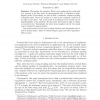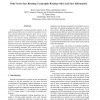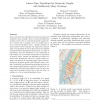109 search results - page 16 / 22 » Edge-Disjoint Paths in Planar Graphs |
SIAMCOMP
1998
13 years 8 months ago
1998
This paper introduces a near-linear time sequential algorithm for constructing a sparse neighborhood cover. This implies analogous improvements (from quadratic to near-linear time)...
APPROX
2010
Springer
13 years 10 months ago
2010
Springer
We consider the question: What is the maximum flow achievable in a network if the flow must be decomposable into a collection of edgedisjoint paths? Equivalently, we wish to find a...
ICNP
2005
IEEE
14 years 2 months ago
2005
IEEE
Existing geographic routing algorithms depend on the planarization of the network connectivity graph for correctness, and the planarization process gives rise to a welldefined no...
KIVS
2011
Springer
12 years 11 months ago
2011
Springer
Localized geographic single path routing along a wireless network graph requires exact location information about the network nodes to assure message delivery guarantees. Node loc...
CORR
2008
Springer
13 years 8 months ago
2008
Springer
We provide linear-time algorithms for geometric graphs with sublinearly many crossings. That is, we provide algorithms running in O(n) time on connected geometric graphs having n ...



